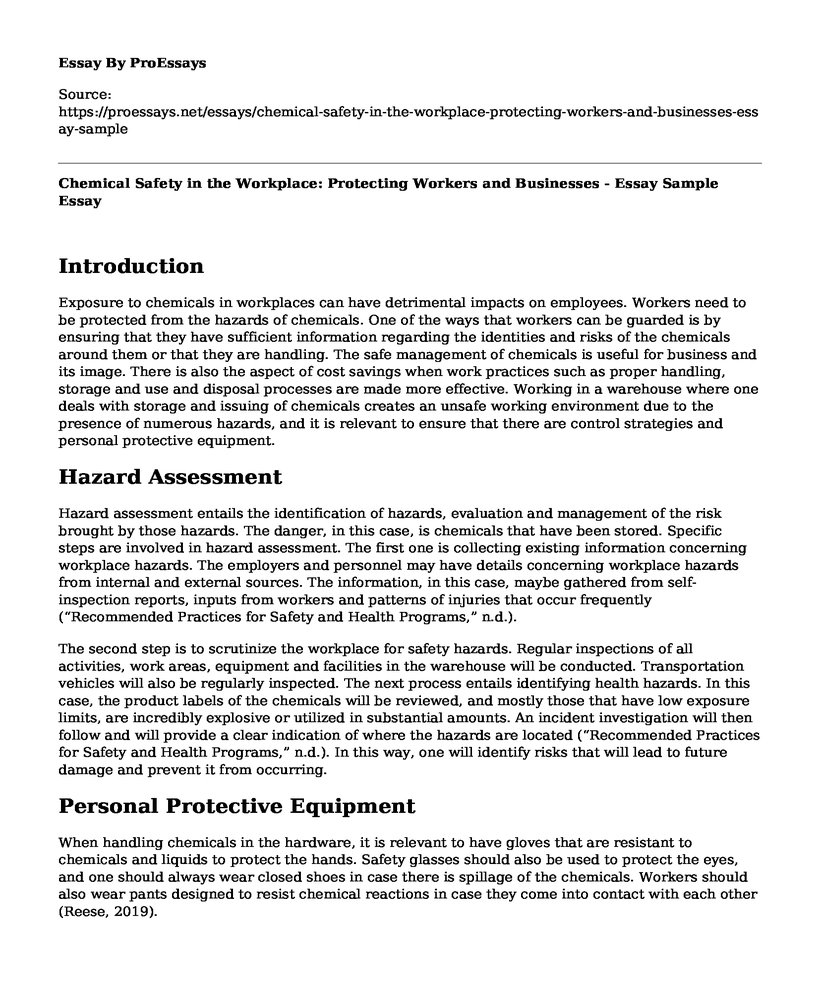Introduction
Exposure to chemicals in workplaces can have detrimental impacts on employees. Workers need to be protected from the hazards of chemicals. One of the ways that workers can be guarded is by ensuring that they have sufficient information regarding the identities and risks of the chemicals around them or that they are handling. The safe management of chemicals is useful for business and its image. There is also the aspect of cost savings when work practices such as proper handling, storage and use and disposal processes are made more effective. Working in a warehouse where one deals with storage and issuing of chemicals creates an unsafe working environment due to the presence of numerous hazards, and it is relevant to ensure that there are control strategies and personal protective equipment.
Hazard Assessment
Hazard assessment entails the identification of hazards, evaluation and management of the risk brought by those hazards. The danger, in this case, is chemicals that have been stored. Specific steps are involved in hazard assessment. The first one is collecting existing information concerning workplace hazards. The employers and personnel may have details concerning workplace hazards from internal and external sources. The information, in this case, maybe gathered from self-inspection reports, inputs from workers and patterns of injuries that occur frequently (“Recommended Practices for Safety and Health Programs,” n.d.).
The second step is to scrutinize the workplace for safety hazards. Regular inspections of all activities, work areas, equipment and facilities in the warehouse will be conducted. Transportation vehicles will also be regularly inspected. The next process entails identifying health hazards. In this case, the product labels of the chemicals will be reviewed, and mostly those that have low exposure limits, are incredibly explosive or utilized in substantial amounts. An incident investigation will then follow and will provide a clear indication of where the hazards are located (“Recommended Practices for Safety and Health Programs,” n.d.). In this way, one will identify risks that will lead to future damage and prevent it from occurring.
Personal Protective Equipment
When handling chemicals in the hardware, it is relevant to have gloves that are resistant to chemicals and liquids to protect the hands. Safety glasses should also be used to protect the eyes, and one should always wear closed shoes in case there is spillage of the chemicals. Workers should also wear pants designed to resist chemical reactions in case they come into contact with each other (Reese, 2019).
Evaluation of Employees Exposures to Chemical Hazard
All workers who handle hazardous chemicals will be given labels and safety data sheets. They will then be trained and imparted with knowledge about the threats of chemicals that they are handling and measures that they can take to guard themselves against any harm. An evaluation test can then be issued to demonstrate whether workers have comprehended what they have been taught.
Control Methods to Reduce Exposure of Employees
One of the control methods that will be applied after employees’ exposure to exceeding levels of the chemical in the warehouse is altering the structure of the work region. It will ensure that exposure to the chemicals has been reduced. Some chemicals can be moved in a different storage area, and the workers given more safety devices. Also, some region will be hindered from access and only done so under close supervision. As such, this control is useful as it will ensure the risk has been minimized. Another control method entails personal protective equipment (PPE). Workers will be supervised to ensure that they have all the protective clothing, gloves and safety glasses (“Recommended Practices for Safety and Health Programs,” n.d.). It will ensure that all workers are protected including those who might not be fully aware of the relevance of this protective equipment.
Evaluation of Effectiveness of Control Methods
The control methods can be evaluated by assessing the number of accidents reported. In case there is an increase, then it means they are not sufficient. However, a decline in the number of accidents indicates that the control methods are efficient. Also, employees can be asked to report whether they feel safer in the work station. A positive or negative report will give one comprehension of whether the control methods are effective.
References
Recommended Practices for Safety and Health Programs. United States Department of Labor. Retrieved 15 May 2020, from https://www.osha.gov/shpguidelines/hazard-Identification.html.
Reese, C. (2018). Handbook of Safety and Health for the Service Industry - 4 Volume Set. CRC Press.
Cite this page
Chemical Safety in the Workplace: Protecting Workers and Businesses - Essay Sample. (2023, Aug 01). Retrieved from https://proessays.net/essays/chemical-safety-in-the-workplace-protecting-workers-and-businesses-essay-sample
If you are the original author of this essay and no longer wish to have it published on the ProEssays website, please click below to request its removal:
- Essay on Recruiting Athletes for Softball
- Phoenix Advertising Employees' Issues Paper Example
- Essay Sample on On-the-Job Training (OJT)
- Essay Example on High Performance Leadership: The Managerial Grid of Bill Gates
- Paper Example on Toyota's Efficiency: Minimizing Slack Resources & Wastage
- Pfizer: Improving Employees' Performance & Efficiency - Free Essay Sample
- Paper Example on DRA PS-Human Resources Management







